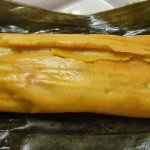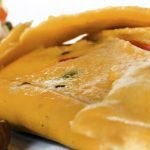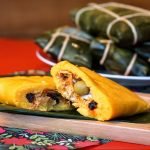About me
- Homepage
- >>
- About me
Hallaca is a staple of Venezuelan Christmas celebrations
Hallaca is a Venezuelan dish. It consists of corn dough stuffed with a stew of beef, pork, or chicken and other ingredients such as raisins, capers, and olives Like some tamales, hallacas are folded in plantain leaves, tied with strings, and boiled.
The dish is traditionally served during the Christmas season and has several regional variants in Venezuela.
It has been described as a national dish of Venezuela. A characteristic of the hallaca is the delicate corn dough made with consommé or broth and lard colored with annatto.
How to made the Hallacas?
Hallaca filling is more elaborate than the standard tamale filling. Ingredients differ from region to region and from family to family but may include a combination of beef, pork, bacon, lard, onion, sweet pepper, red pepper, scallion, garlic, salt, pepper, oregano, cumin and some type of cooking wine or vinegar. In the version from the Venezuelan Andes hallacas are made with guiso crudo which differ from other versions because the meat filling is not pre-cooked. Some versions of the filling include leeks, Worcestershire sauce, mustard pickles, panela, or dark brown sugar. The stew is simmered over low heat slowly for several hours.
In Aruba and Curaçao, two islands just off the coast of Falcón state, Venezuela, it is called ‘ayaca’ or ‘ayaka’. The ingredients are pork and chicken stew, or pork or chicken stew, capers, raisins, cashews, bellpepper, pickled baby onions, prunes, and olives. The dough is made from white cornmeal, and the ayaca leaves first spread with lard or oil. Cooked meat and other ingredients are then wrapped in ayaca leaves, tied with string and then boiled for about 2 hours. Flavors in the ayaca vary from family to family, and some add madam Jeanet peppers (very hot).
In Puerto Rican cuisine the dish is called hayaca and used to be a popular part of the island’s cuisine. Unlike the Venezuelan variety, hayaca from Puerto Rico is not made with corn but with cassava, milk, annatto, and banana leaf, and baked in traditional open-wood-fire. Because of the long and elaborate process and skills that takes to prepare, the hayaca is now rarely available but is still found, mostly in coastal, family-owned restaurants and other small establishments known as “kioscos” where there are still strong ties to native heritage and classic slow cooking skills.
The corn dough is similar to a standard arepas dough. Pork fat is melted down with annatto to add color. Corn flour is kneaded together with broth and some soft butter and the cooled pork fat mixture is incorporated to make a soft dough with a golden color. A large plantain leaf is greased with vegetable oil and the dough is flattened on the leaf to about a quarter inch thickness . The guiso filling is topped with a combination of onion, pepper, parsley, potatoes, raisins, almonds, chickpeas, capers, green olives, hard boiled eggs and bacon. The leaf is tied and boiled at a low heat.
Hallaca can be made in advance and frozen.



